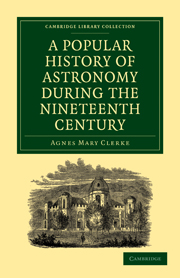Summary
We can distinguish three kinds of astronomy, each with a different origin and history, but all mutually dependent, and composing, in their fundamental unity, one science. First in order of time came the art of observing the returns and measuring the places of the heavenly bodies. This was the sole astronomy of the Chinese and Chaldeans; but to it the vigorous Greek mind added a highly complex geometrical plan of their movements, for which Copernicus substituted a more harmonious system, without as yet any idea of a compelling cause. The planets revolved in circles because it was their nature to do so, just as laudanum sets to sleep because it possesses a virtus dormitiva. This first and oldest branch is known as “observational,” or “practical astronomy.” Its business is to note facts as accurately as possible; and it is essentially unconcerned with schemes for connecting those facts in a manner satisfactory to the reason.
The second kind of astronomy was founded by Newton. Its nature is best indicated by the term “gravitational;” but it is also called “theoretical astronomy.” It is based on the idea of cause; and the whole of its elaborate structure is reared according to the dictates of a single law, simple in itself, but the tangled web of whose consequences can be unravelled only by the subtle agency of an elaborate calculus.
- Type
- Chapter
- Information
- Publisher: Cambridge University PressPrint publication year: 2010First published in: 1885



